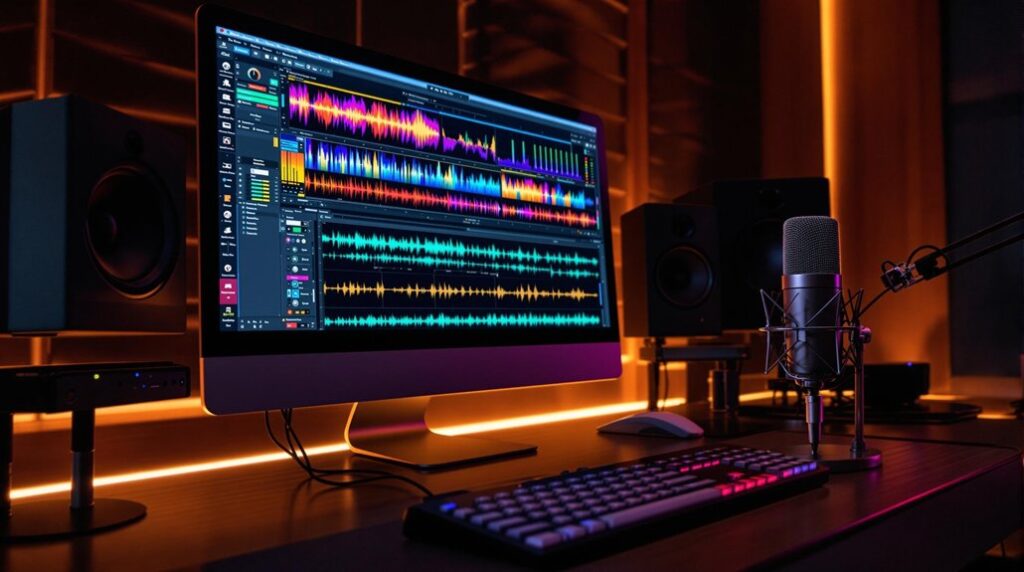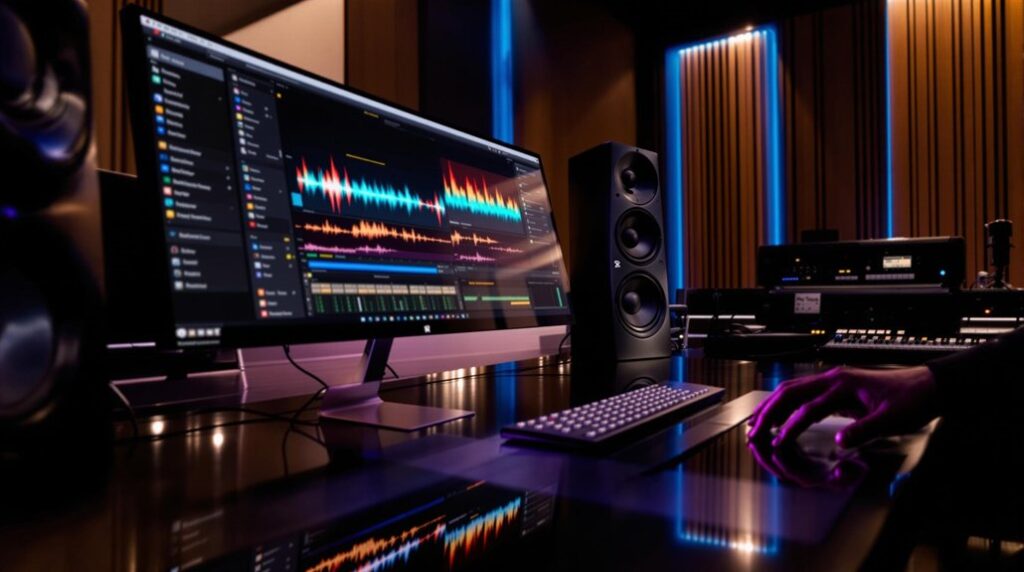To change tempo in Pro Tools, first activate Conductor Mode in the MIDI Controls to use the tempo map. Open the Transport Window with Cmd+1 (Mac) or Ctrl+1 (PC), and enable the Tempo Ruler to visualize tempo changes. Add tempo changes by selecting a bar and clicking the "+" next to the Tempo Ruler to input new BPM values. For gradual shifts, use the Pencil tool in Line mode across the Tempo Ruler. Troubleshoot any issues by verifying global tempo settings and using Elastic Audio. Each step builds on the last, offering expanded control and precision over tempo adjustments.
Key Takeaways
- Enable Conductor Mode to allow tempo changes governed by the tempo map.
- Access Tempo Controls through the Transport Window for visualization and adjustments.
- Display the Tempo Ruler and input new BPM values for desired changes.
- Use the Pencil tool for drawing gradual tempo shifts on the Tempo Ruler.
- Create a click track to ensure alignment with tempo modifications.
Enable Conductor Mode
When preparing to change tempo in Pro Tools, enabling Conductor Mode is an important first step.
To enable Conductor Mode, click the conductor icon in the MIDI Controls section, which resembles a conductor with a baton. This action guarantees that tempo changes are governed by the tempo map rather than manual input.
Once activated, the tempo bar will appear at the top of the session window, offering a visual representation of tempo changes. This setup is vital for synchronizing with the click track and any tempo alterations.
Additionally, users can customize their workflow by choosing to display or hide rulers for tempo, markers, meter, key, and chords. This approach facilitates precise and efficient management of tempo changes during recording or playback.
Access Tempo Controls
Accessing tempo controls in Pro Tools is a straightforward process essential for precise tempo management.
Begin by opening the Transport Window using Cmd+1 on Mac or Ctrl+1 on PC. This window is integral to change the tempo efficiently.
Next, enable the Tempo Ruler by steering to "View > Rulers > Tempo," allowing you to visualize and adjust the tempo within your session.
For detailed tempo adjustments, the Tempo Editor provides precise BPM changes and thorough tempo mapping capabilities.
To create a tempo manually, enter the desired BPM value directly within the Transport Window.
For more intricate tempo modifications, the Tempo Operations window offers extensive control, allowing the adjustment of multiple tempo settings simultaneously.
These tools guarantee precise and flexible tempo management in Pro Tools.
Add Tempo Changes
To efficiently integrate tempo changes in Pro Tools, verify the Tempo Ruler is prominently displayed within the Edit window by maneuvering to "View > Rulers > Tempo."
Select the exact bar where the tempo adjustment is desired, then click the "+" icon adjacent to the Tempo Ruler to access the tempo change dialog. Input the new beats per minute (BPM) value to add tempo changes precisely. Confirm your adjustments by clicking "OK."
This procedure guarantees seamless tempo changes within your session. Utilize the Create Click Track feature, which automatically aligns with any tempo modifications, maintaining consistent rhythm.
For enhanced control, consider manually adjusting the tempo with the Pencil tool on the Tempo Ruler, enabling custom tempo variations as needed.
Draw Gradual Tempo Shifts
Implementing gradual tempo shifts in Pro Tools requires precision and control, which can be effectively achieved using the Pencil tool set to line mode. By clicking and dragging on the Tempo Ruler, you can draw a straight line to shift smoothly between different BPMs. This technique facilitates even distribution of tempo changes across selected bars, ensuring seamless musical flow. Utilize the Pencil tool in line mode for precision. Draw on the Tempo Ruler to visualize tempo changes. Create a click track to maintain consistent rhythm. Use the automation feature to record real-time adjustments. Visualize the gradual tempo shift for clarity and control. For precise editing, understanding both modes in Pro Tools is essential to achieve the desired results, whether aligning clips to a grid or allowing for freeform placement. The visual representation on the Tempo Ruler allows for easy manipulation, enhancing the musical expression through dynamic tempo changes.
Troubleshoot Tempo Issues
Begin by verifying Pro Tools' global tempo settings to guarantee synchronization with MIDI controllers or audio interfaces, preventing session discrepancies. Employ Elastic Audio to adjust imported audio, aligning it with the session's tempo to avoid playback disruptions. Scrutinize the tempo map for unintentional changes or misplaced markers that might affect the session's flow. Temporarily disable tempo-based effects to isolate their impact on track tempo fluctuations. Consolidate glitching tracks to rectify any inconsistencies, guaranteeing a seamless audio experience. Utilize the Conductor Track in Pro Tools to precisely manage and map tempo changes at specific Bar|Beat locations, ensuring the rhythmic integrity of your project.
Frequently Asked Questions
How to Do a Tempo Change in Pro Tools?
To execute a tempo change in Pro Tools, utilize tempo mapping within session settings. Adjust the time signature and musical grid for rhythmic variations. Employ tempo automation for gradual shifts and guarantee audio stretching aligns with new tempo parameters.
How Do I Change the Speed in Pro Tools?
To change speed in Pro Tools, employ tempo manipulation techniques using Pro Tools shortcuts. Access tempo mapping methods via audio editing tips and music production tools, enhancing your creative workflow with precise software integration strategies for seamless tempo adjustments.
How to Conduct Tempo Change?
To effectively conduct a tempo change, utilize tempo mapping techniques and rhythmic variation strategies within your digital audio basics. Employ MIDI editing practices and audio mixing methods to explore creative tempo ideas, enhancing your music arrangement tips effectively.
How Do You Change the Tempo of a Sample?
To change a sample's tempo, employ tempo adjustment techniques in Pro Tools. Utilize sample editing methods, including tempo mapping tips, audio stretching options, and time signature changes. Implement beat matching strategies and Pro Tools shortcuts for efficient workflow management.
Conclusion
In summary, the process of altering tempo in Pro Tools involves several precise steps. Enabling Conductor Mode is the initial requirement to access and manipulate tempo controls effectively. Subsequent steps include adding specific tempo changes and employing the tempo drawing tool to create gradual shifts, which guarantee smooth changes within a musical piece. Troubleshooting potential issues is also essential for maintaining the desired tempo modifications. Mastery of these techniques enhances the flexibility and expressiveness of audio projects in Pro Tools.




